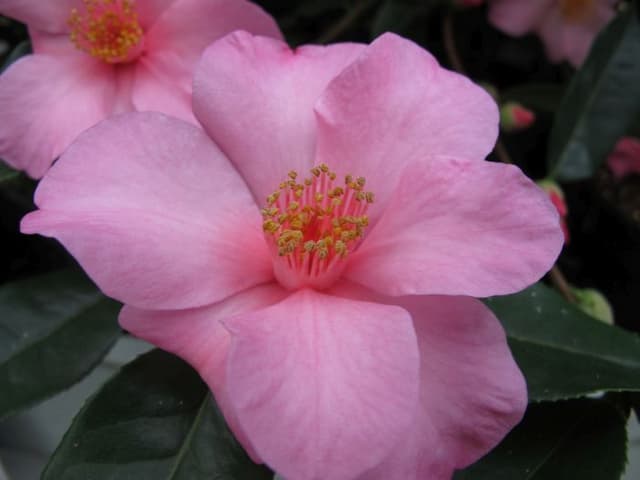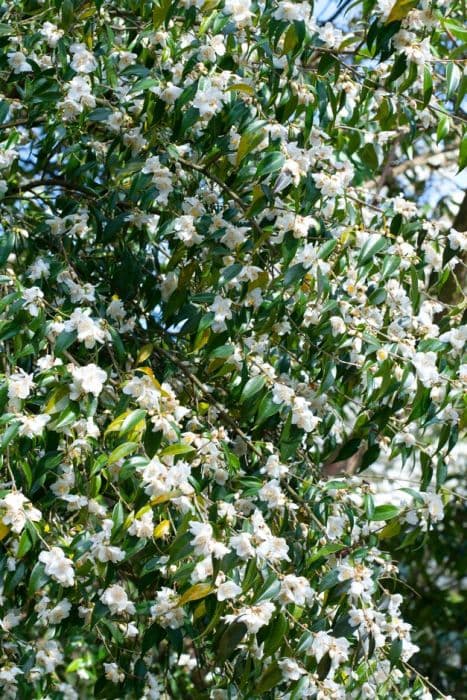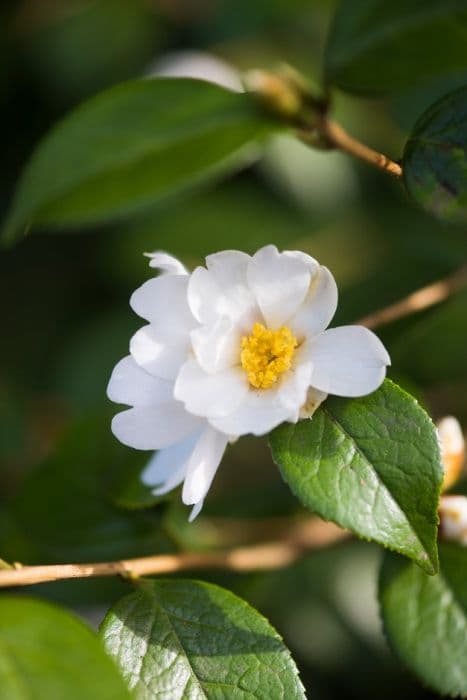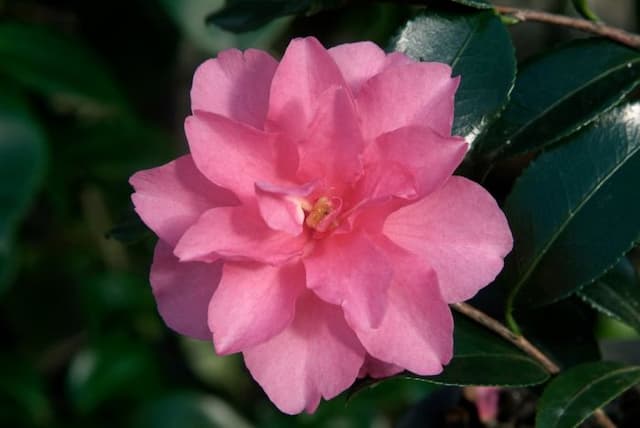Japanese Camellia Camellia japonica 'Bob's Tinsie'

ABOUT
The Camellia japonica 'Bob's Tinsie' is characterized by its lush, dark green leaves that provide a stunning backdrop to its vibrant blossoms. The leaves are glossy and have a leathery texture with serrated edges, creating an elegant silhouette. Its flowers are truly the centerpiece, boasting a delightful shade that ranges from deep pink to almost red. These blossoms have a peony-like form, featuring multiple layers of ruffled petals that create a full and round appearance. At the center of the flower, a cluster of bright yellow stamens adds a pop of color, creating a striking contrast against the deep tones of the petals. The overall appearance of 'Bob's Tinsie' is one of classic beauty, with a compact and bushy growth habit that makes it a favored choice for ornamental gardens. The plant exudes a sense of romanticism and charm, enchanting onlookers with its showy flowers and dense foliage.
About this plant
 Names
NamesFamily
Theaceae
Synonyms
Japanese Camellia, Rose Of Winter
Common names
Camellia japonica 'Bob's Tinsie'.
 Toxicity
ToxicityTo humans
The Japanese camellia is not considered toxic to humans. Therefore, ingesting parts of Camellia japonica 'Bob's Tinsie' typically does not cause poisoning or adverse symptoms in humans.
To pets
The Japanese camellia is also not considered toxic to pets. It should not cause poisoning or adverse symptoms if pets ingest parts of Camellia japonica 'Bob's Tinsie'.
 Characteristics
CharacteristicsLife cycle
Perennials
Foliage type
Evergreen
Color of leaves
Green
Flower color
Red
Height
2-3 feet [60-90 cm]
Spread
2-3 feet [60-90 cm]
Plant type
Shrub
Hardiness zones
7
Native area
Japan
Benefits
 General Benefits
General Benefits- Ornamental Appeal: Features attractive, glossy evergreen leaves and beautiful rose-like flowers that enhance garden aesthetics.
- Seasonal Interest: Blooms in late winter to early spring, providing color during a time when few other plants flower.
- Low Maintenance: Requires minimal pruning and upkeep once established, saving time and effort for gardeners.
- Drought Tolerance: Once established, can withstand dry periods, reducing the need for frequent watering.
- Cold Resistance: Capable of withstanding cooler temperatures, making it suitable for a variety of climates.
- Habitat Support: Provides nectar for pollinators such as bees, which are essential for the pollination of many other plants.
- Versatility: Can be used in various garden settings, including borders, hedges, and as a specimen plant.
- Longevity: Typically has a long lifespan, offering many years of enjoyment without needing to be replaced.
- Privacy Screen: Dense growth habit can be used to create a natural privacy screen or windbreak.
 Medical Properties
Medical PropertiesThis plant is not used for medical purposes.
 Air-purifying Qualities
Air-purifying QualitiesThis plant is not specifically known for air purifying qualities.
 Other Uses
Other Uses- Camellia japonica 'Bob's Tinsie' can be used in floral art and ikebana, the Japanese art of flower arrangement, offering striking blooms and foliage to any display.
- As a natural dye, the petals of Camellia japonica can impart subtle colors to fabrics and papers, creating unique art materials.
- In miniature bonsai gardening, enthusiasts sometimes use this plant for its rich colored blossoms and adaptable nature to the meticulous pruning and care of bonsai techniques.
- The leaves can be used as a natural shine enhancer for dark hair when boiled in water, creating a final rinse solution after shampooing.
- Crafted into garlands or headdresses, Camellia japonica flowers are sometimes seen in traditional ceremonies and weddings for their beauty and elegance.
- The sturdy wood of Camellia japonica can be used in the creation of small objects such as buttons, hairpins, or ornaments, a practice related to its usage in its native country Japan.
- Camellia japonica petals have been utilized in crafts and decoupage, pressed and applied to items like candles and cards to enhance their aesthetic with a floral touch.
- During special occasions, the flowers are floated in bowls of water as a decorative element in homes or at events, illustrating the serenity of nature indoors.
- Used in photography and botanical illustration, Camellia japonica 'Bob's Tinsie' serves as a beautiful subject matter, showing rich color and texture contrasts.
- As a theme in fabric or wallpaper design, the distinctive pattern of Camellia japonica is a favorite for imbuing elegance and botanical charm into interior designs.
Interesting Facts
 Feng Shui
Feng ShuiThe plant Camellia is not used in Feng Shui practice.
 Zodiac Sign Compitability
Zodiac Sign CompitabilityThe plant Camellia is not used in astrology practice.
 Plant Symbolism
Plant Symbolism- Adoration and Love: Camellias symbolize deep love and adoration. The richness of its blooms expresses longing and desire, making it a perfect gift for romantic partners.
- Perfection and Excellence: The flawless form of the camellia blossom represents perfection in many cultures, reflecting excellence and faultless beauty.
- Affection: Often given to express genuine affection towards someone, camellias carry the message of personal and deep-rooted fondness.
- Longevity and Faithfulness: The enduring nature of the camellia flower suggests both longevity and the steadfastness of love, indicating a commitment that lasts over time.
- Admiration: The camellia is commonly given as a token of admiration for someone’s accomplishments or qualities.
 Water
WaterJapanese camellias, including 'Bob's Tinsie', prefer evenly moist soil that is not waterlogged. Watering should be done thoroughly, to ensure the entire root ball is moistened, typically with 1-2 gallons depending on the size of the plant and the weather conditions. During the growing season, water the camellia once a week, but adjust frequency during extremely hot or dry periods by increasing to twice a week. In the winter, when the plant is dormant, reduce watering to every two to three weeks. Always check the soil moisture before watering to avoid overwatering, which can lead to root rot.
 Light
LightJapanese camellias like 'Bob's Tinsie' thrive best in partial shade. The ideal location would provide morning sun and afternoon shade, preventing the harsh midday sunlight which can scorch the leaves. Dappled sunlight beneath the canopy of open-branched trees is also beneficial for these camellias, as it replicates their natural habitat.
 Temperature
TemperatureJapanese camellias, such as 'Bob's Tinsie', grow best in a temperature range of 60-70 degrees Fahrenheit but can tolerate temperatures as low as 10 degrees and as high as 100 degrees Fahrenheit. They are hardy in USDA zones 7 to 9, and protection from cold winds and late frosts is recommended to preserve blossoms and tender growth.
 Pruning
PruningPrune Japanese camellias such as 'Bob's Tinsie' to maintain shape and remove dead or weak wood. The best time to prune is just after blooming ends in spring, as camellias set their buds for the following year in summer. Light pruning can be done annually, but extensive pruning should be done less frequently as it can reduce flowering for a year or two.
 Cleaning
CleaningAs needed
 Soil
SoilCamellia, commonly known as the Japanese Camellia, thrives in well-draining, acidic soil with a pH range of 5.5 to 6.5. A suitable mix would include 1/3 peat moss, 1/3 pine bark, and 1/3 perlite or vermiculite to ensure good aeration and moisture retention.
 Repotting
RepottingJapanese Camellias like 'Bob's Tinsie' should be repotted every 2 to 3 years, and preferably in the spring before the onset of the growth season.
 Humidity & Misting
Humidity & MistingJapanese Camellias prefer high humidity levels, ideally between 40-60%, to support their lush foliage and flower development.
 Suitable locations
Suitable locationsIndoor
For growing Japanese Camellia indoors, ensure bright, indirect light and high humidity.
Outdoor
Plant Japanese Camellia in partial shade and shelter from strong winds.
Hardiness zone
7-9 USDA.
 Life cycle
Life cycleCamellia japonica 'Bob's Tinsie', commonly known as Japanese Camellia, begins its life as a seed, requiring a period of stratification to break dormancy before germination. Upon sprouting, the seedling stage sees the plant establishing roots and a set of true leaves, which are characteristically glossy and dark green. As a juvenile, the camellia develops a woody stem and a compact, bushy form, becoming increasingly robust. In maturity, 'Bob's Tinsie' reaches full size and starts to produce its distinctive, small, formal double flowers, typically bright red or pink, blooming from winter to spring in milder climates. After peak reproductive years, the plant may enter a period of senescence, with slower growth and reduced flowering, but can live for many decades with proper care. When conditions allow, it can also produce seeds to complete its reproductive cycle, contributing to the perpetuation of the species.
 Propogation
PropogationPropogation time
Spring-Early Summer
Camellia japonica 'Bob's Tinsie', commonly known as camellia, is generally propagated by semi-hardwood cuttings taken in late summer to early fall. To propagate by cuttings, one would select a healthy stem that's not too young nor too mature, typically around 4-6 inches long (10-15 cm). The lower leaves are removed and the cut end is dipped into rooting hormone before being placed into a mixture of peat and perlite or sand for rooting. This medium should be kept moist but not overly wet, and the container should be covered with plastic or placed in a greenhouse to maintain high humidity. Roots are expected to form in several weeks to months, after which the new plants can be transplanted into individual pots with potting soil.









